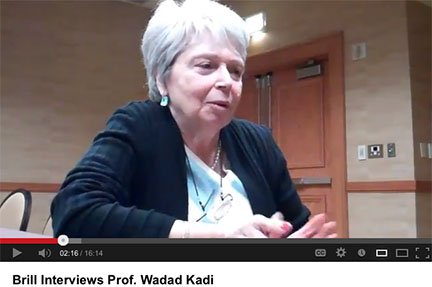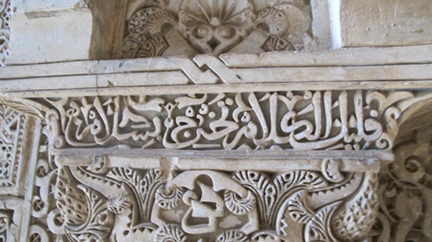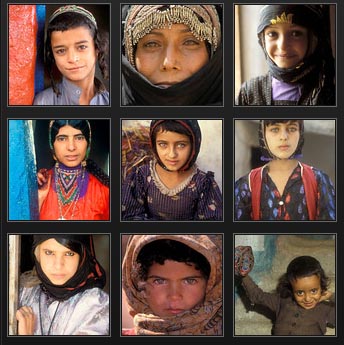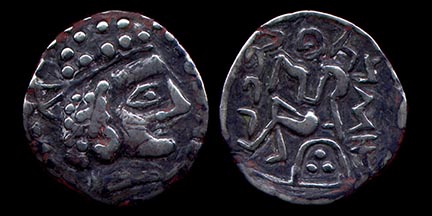
The well-known historian of Islam Wadad Kadi was interviewed at the 2012 MESA meeting in Denver about her work and her involvement in several projects with Brill. You can watch the interview on Youtube.

The well-known historian of Islam Wadad Kadi was interviewed at the 2012 MESA meeting in Denver about her work and her involvement in several projects with Brill. You can watch the interview on Youtube.

Yemenis seeking American citizenship pay exorbitant dowries in lucrative marriages of convenience
by Nadia Haddash, Yemen Times, March 7, 2013
Getting a visa from the American embassy in Sana’a is not easy for Yemenis hoping to travel to the U.S., and is especially hard for young, single men. So, many seek an alternative route: marrying a Yemeni-American woman.
By doing so, they typically become American, too, but could be in debt for years—they often have to pay huge dowries for their dual citizen brides.
Walid Al-Asimi, 28, met his wife, a Yemeni-American, in an English institute in Sana’a.
“When I knew that she would travel to America I decided to marry her,†he says. “I was surprised when her father asked me to give $30,000 as a dowry.â€
The majority of Yemeni youths who marry women with dual citizenship pay very high dowries, ranging between$10,000-50,000, or around YR 2 million- 11 million. By comparison, a typical dowry paid to a bride’s family in Sana’a is around $4,000 or YR 800,000. The dowry paid to brides’ families in rural areas of the country is much less still. Continue reading Passport Blues

By Anouar Majid, Tingis Redux, February 22nd
A few months ago, I immersed myself in a kind of reading that I wish was available to me and my teachers when I was in high school in Tangier (Morocco) studying philosophy and Islamic Studies. It is the kind of slow—very slow—reading that keeps you constantly challenged and fully awake. It is archeological and historical work informed by a knowledge so vast that a reader must struggle to keep track of all sorts of cultures, languages, dates, and names. Only scholarship of this scope, though, can aim at the heart of gigantic myths—myths so powerful and persistent that centuries of generations have taken them for reality and billions continue to believe in their truth.
I decided to devote some time to the work of Professor Patricia Crone because her name kept appearing with increasing frequency in the literature I had been reading in the last few years, whether by scholars who share her general view or not. I thought it was time to have a first-hand experience of what Crone’s thesis is about. So, in no particular order, and rather quickly, I read God’s Rule: Government and Islam (2004), co-written with Martin Hinds; Meccan Trade and the Rise of Islam (first published in 1987); Slaves on Horses (1980) and Hagarism: The Making of the Islamic World, the book she co-authored with Michael Cook in 1977 and which caused a storm in the rarified circles of scholars. Even though she may have changed her mind since she published the book in 1977, Hagarism and Meccan Trade totally upset the foundations of what we have grown to believe is Muslim history. They show, as do other writers in different ways, like Arthur Jeffery, John Wansborough, and, more recently, Fred Donner, Tom Holland and Robert Spencer, that what Muslims and non-Muslims learn in school about Islam is not facts that happened but literary compositions whose aim was to create a new religion with its own legitimizing mythology.
A Religion is Born
Muslims believe that their Prophet Mohammed, who was born in 570 AD and died in 632 AD, is the best human ever born in the world, chosen by God to spread his final and everlasting message, preserved in a heavenly tablet, the Koran. Starting out from humble origins in Mecca—a bustling crossroads in the caravan trade—and reputed for his honesty and wisdom, Mohammed married his older boss Khadija, received God’s message through the archangel Gabriel at a local cave when he was 40, fled his native city and migrated to Yathrib (thereafter known as Medina) when his persecution grew more intense, and later returned to Mecca as a triumphant Muslim conqueror. By the time he died, he had married several times and most of Arabia had converted to Islam. Soon his followers, known as Muslims, fanned out in a series of conquests (downplayed as futuhat in Islamic apologetics) that, within a century, had reached France and turned the Fertile Crescent, North Africa and the Iberian Peninsula into Muslim nations. Continue reading Islam: The Arab Religion

An exhibition of photographs of Yemenite Jews is on display from February 1- April 30, 2013 at the Katz Snyder Gallery in San Francisco. The entire collection can be seen online.
Israeli photojournalist Naftali Hilger’s breathtaking photos of Yemen reveal a nation and a landscape lost in time. His intimate portraits of the isolated Jewish communities of Yemen, taken over a period of 20 years, have been most recently seen in a widely heralded exhibition at the Museum of Islamic Art in Jerusalem.
Hilger’s life-altering love affair with the mysteries of Yemen began in 1987. Over six subsequent trips from 1987 through 2008, he documented not only one of the most ancient communities in the Jewish diaspora, but Muslim Yemen as well – its markets, its landscapes and the fascinating architecture of Sana’a and the rural villages.


Anwar al-Awlaki, left, an operative in Al Qaeda’s Yemeni branch, was targeted in a strike that also killed Samir Khan, the creative force at a militant Web magazine. Both were Americans; Left, Linda Spillers for The New York Times; right, WBTV, via Associated Press
Today’s New York Times features a major article by MARK MAZZETTI, CHARLIE SAVAGE and SCOTT SHANE entitled “How a U.S. Citizen Came to Be in America’s Cross Hairs.” Actually the article discusses how three American citizens were the victims of drone attacks in Yemen in late 2011. The primary target was Anwar al-Awlaqi, who is described in the article as “the firebrand preacher, born in New Mexico, who had evolved from a peddler of Internet hatred to a senior operative in Al Qaeda’s branch in Yemen.” He was a socially mediated firebrand, far better known for his English than having an impact on recruiting terrorists in Yemen. Killed in the same after-breakfast attack was Samir Khan, “the creative force behind Inspire, the militant group’s English-language Internet magazine” and someone (basically a propaganda journalist) who was not considered important enough to specifically target. The article continues: “The next month, another drone strike mistakenly killed Mr. Awlaki’s 16-year-old son, Abdulrahman, who had set off into the Yemeni desert in search of his father. Within just two weeks, the American government had killed three of its own citizens in Yemen. Only one had been killed on purpose.” The 16-year old fell victim to a botched targeting:
Then, on Oct. 14, a missile apparently intended for an Egyptian Qaeda operative, Ibrahim al-Banna, hit a modest outdoor eating place in Shabwa. The intelligence was bad: Mr. Banna was not there, and among about a dozen men killed was the young Abdulrahman al-Awlaki, who had no connection to terrorism and would never have been deliberately targeted.
The drone issue has recently resurfaced, most notably in Mr-Rand-Paul-goes-to-Washington’s 13 hour filibuster. Continue reading Dro[w]ning life, liberty and the pursuit of not being targeted

‘Great Ruler of Sogdiana, of the Tchao-ou Race’/Alram’s ‘Imitationsgruppe V’
Yueh Chih Principality of Sogdiana AR Tetradrachm, 130 BCE – 80 CE
The Fifth Seminar in Central Asian and Middle Eastern Numismatics in Memoriam Boris Kochnev will be held at Hofstra University on Saturday, March 16, 2013.
This seminar is free and open to the public. Hofstra is located in Hempstead, NY, easily accessible from NYC by the Long Island Railroad. For directions click here or here. The seminar will be held in Breslin Hall, room 112. For more information, contact Aleksandr Naymark or Daniel Martin Varisco.
Seminar Program:
10:00 am
Daniel Varisco (Hofstra University)
Opening Remarks
10:15
Vadimir Belyaev (Zeno.ru, Moscow) and Aleksandr Naymark (Hofstra University)
Archer Coins from South Sogdiana (1st – 3rd centuries C.E.)
10:45 pm
Pankaj Tandon (Boston University)
Notes on Alchon Coins
11:15 pm
Waleed Ziad (Yale University)
The Nezak – Turk Shahi Transition:
Evidence from the Kashmir Smast (mid 7th c. C.E.) Continue reading Central Asian and Middle Eastern Numismatics Seminar

For International Women’s Day, it is important to reflect on issues that are of significant impact on women around the world. Let’s start with a beginning, the Genesis one. The original creation story familiar to Judaism, Christianity and Islam starts out with man alone. Not only is the first man not like other animals, which he has no problem naming, but he has no family: no nurturing mother, no moral father, no brothers or sisters. He was formed as a lump of clay with breath and a spirit connection to the divine. Even the presence of God, his creator father figure, was not enough for this lonely man. Surely this garden paradise was hell for the man alone.
So God put Adam to sleep, extracted a rib and fashioned a woman to be his mate. But again this was still a fool’s paradise with no other human beings around the first pair. No doubt it was less boring, but there seem to have been few challenges for the couple, since everything they needed (except clothes which were not yet fashioned) were at hand. Yes, they had each other, but apparently only as a brother and sister might. Until that fruitful day when Eve bit into the knowledge of good and evil, it must have been boring beyond belief. Disobedience by the pair, something quite normal for all children who could hardly know better, led to a disaster for the first couple, their children and all children ever after. So the story goes. Hell would now shift from the lonely boredom of Paradise to the sweat and blood reality of a world where both had to work for a living.
The gender gap, foretold in the curses on Adam and Eve, has many variants, but the vast majority of societies give the male precedence. Post Eden became a man’s world, where brother kills brother and the line of begats is male to a fault. One assumes all this begetting involved sex, but the opening chapters of Genesis are strangely silent about sex. One can understand the desire not to draw attention to the original incest, but one wonders about the libido of these descendants of Adam and Eve. By the time of Noah sex is a serious issue, one in which the “sons of God” saw that the “daughters of men” were “fair”, at least in the sense of fair game. So when we are told “And God saw that the wickedness of man was great in the earth, and that every imagination of the thoughts of his heart was only evil continually” (Genesis 6:5), we have finally arrived at and beyond what might be called the gender gape. Continue reading Rape and the Gender Gape

The following Yemeni poem about qat (Catha edulis), accompanied by the photograph above of a Yemeni girl, was provided by a friend.
